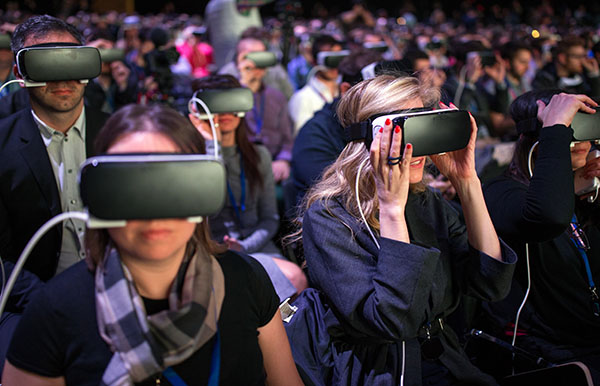
Staff Blog: Mucking about with 360 VideoSphere VR Part 3
Interested in 360 VideoSphere (360 Virtual Reality)? This series shares what I learnt producing a short film aboard an old Sailing Ship for the Melbourne Fringe Festival[1].


Interested in 360 VideoSphere (360 Virtual Reality)? This series shares what I learnt producing a short film aboard an old Sailing Ship for the Melbourne Fringe Festival[1].

Interested in 360 VR (VideoSphere)? This series shares what I learnt producing one aboard an old Sailing Ship for the Melbourne Fringe Festival[1].

I looked about Antarctica in all directions. From the snowy landscape rising towards the centre of the continent to the waves breaking against the beach; a beach made of large pebbles, clearly visible at my feet.

In this day and age, we can use social media, augmented reality and virtual reality to drive social change by altering the way we campaign for causes. When a potential audience of billions can be reached with content to highlight a social issue, the impact is often swift and significant – think of the Ice Bucket Challenge. Augmented reality (AR), virtual reality (VR) and mixed reality (MR) have major roles to play in an era where change is literally in the palm of anyone’s hand. Here’s why.

For soldiers to be effective, training must resemble real world scenarios as closely as possible. Real life battle conditions are loud, chaotic and dangerous. However augmented reality military training is a safer way to engage soldiers in real life simulations.

We’ve come a long way from television broadcasts of sporting events where inclement weather, bad lighting or overexposure often resulted in dull, poor quality images. We now enjoy crisp, crystal clear footage of our favourite sporting events, on demand, in high definition.

There has been speculation about whether wearable technology gave English Premier League (EPL) team Leicester City the edge it needed to win the Premier League last year. This is especially impressive, considering that the season prior, and the ten years before that, Leicester City was not even in the Premier League to begin with. They had been relegated to the lower divisions and were languishing there for some time.

Two decades on, AR looks set to drastically change the game experience, for both players and punters (the audience, not the kickers). Chris Kluwe, a former NFL punter (kicker, not spectator), asserts that NFL players could have AR technology in their helmets within a few years. At a TED talk in 2014, he explained that in the near future, NFL players could have a heads-up display (HUD), in their helmet visors, much like Google Glass. The system would alert them via flashes or some other visual cue, to an open space on the field, an empty receiver or help them anticipate the trajectory of a pass coming their way.

By now, you would have either experienced Pokemon Go or collided with someone or the other walking around trying to find a pokemon on the streets. Everyone has described this as the first mainstream implementation of Augmented Reality, and frankly speaking it took me a long time to understand exactly what that meant. As with most mysteries – a quick search on google provided the following insight;

Children make up the largest proportion of the population with intellectual disability, with around one-quarter being under the age of 15 years (ABS). Around the world people with other disabilities may include up to 18% of the population (US Census). The recognition that our community needs to integrate everyone, providing opportunities and resources to include everyone in worthwhile pursuits, has forced governments to create legislation to ban biased practices that reduce opportunities for the disabled. In some cases attempts to improve access to resources that create a path to life long learning have also been framed in law (Australian Disability Discrimination Act, The Americans with Disabilities Act of 1990, The Equality Act 2010 and the United Nations (UN) Convention on disability rights).
Necessary cookies are absolutely essential for the website to function properly. These cookies ensure basic functionalities and security features of the website, anonymously.
| Cookie | Duration | Description |
|---|---|---|
| cookielawinfo-checkbox-analytics | 11 months | This cookie is used to store the user consent for the cookies in the category "Analytics". |
| cookielawinfo-checkbox-functional | 11 months | The cookie is set by GDPR cookie consent to record the user consent for the cookies in the category "Functional". |
| cookielawinfo-checkbox-necessary | 11 months | This cookies is used to store the user consent for the cookies in the category "Necessary". |
| cookielawinfo-checkbox-others | 11 months | The cookie is used to store the user consent for the cookies in the category "Other." |
| cookielawinfo-checkbox-performance | 11 months | This cookie is used to store the user consent for the cookies in the category "Performance". |
| viewed_cookie_policy | 11 months | This cookie is used to store whether or not user has consented to the use of cookies. It does not store any personal data. |
Functional cookies help to perform certain functionalities like sharing the content of the website on social media platforms, collect feedbacks, and other third-party features.
Performance cookies are used to understand and analyze the key performance indexes of the website which helps in delivering a better user experience for the visitors.
Analytical cookies are used to understand how visitors interact with the website. These cookies help provide information on metrics the number of visitors, bounce rate, traffic source, etc.
Advertisement cookies are used to provide visitors with relevant ads and marketing campaigns. These cookies track visitors across websites and collect information to provide customized ads.
Other uncategorized cookies are those that are being analyzed and have not been classified into a category as yet.
